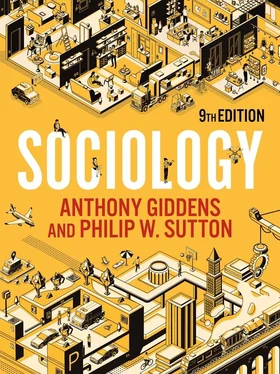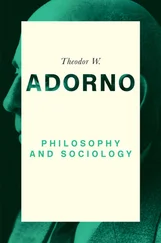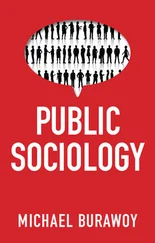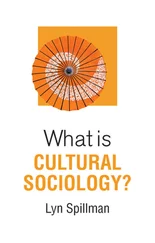
Feminist research and theorizing can be found throughout the various chapters of the book, but there are significant discussions of feminist theory and its development in chapter 3, ‘Theories and Perspectives’, and chapter 7, ‘Gender and Sexuality’.
Weber’s social action approach inspired many ‘interactionist’ forms of sociology. One of the most influential has been symbolic interactionism, which also owes much to the American social philosopher George Herbert Mead (1863–1931). Symbolic interactionism springs from a concern with language and meaning. Mead argues that language allows us to become self-conscious beings – aware of our own individuality and able to see ourselves ‘as others see us’. The key element in this process is the symbol. A symbol is something that stands for something else. For example, words that refer to objects are symbols which represent what we mean. The word ‘spoon’ is a symbol we use to describe the utensil that we use to consume soup. Non-verbal gestures and forms of communication are also symbols. Waving at someone or making a rude gesture both have symbolic value.
Symbolic interactionism directs our attention to the details of interpersonal interaction and how that detail is used to make sense of what others say and do. Sociologists influenced by symbolic interactionism often focus on face-to-face interactions in the context of everyday life. They stress the role interactions play in creating society and its institutions. Max Weber was an important indirect influence on this theoretical approach because, although he acknowledged the existence of social structures, he held that these were created through the actions of individuals.
While the symbolic interactionist perspective has yielded many insights into the nature of our actions in the course of day-to-day social life, it has been criticized for ignoring the larger issues of power and social structure and how these serve to constrain individual action. However, one very good example of interactionism that does take into account such issues is Arlie Hochschild’s (1983) The Managed Heart: Commercialization of Human Feeling . Hochschild observed training sessions and carried out interviews at Delta Airlines’ Stewardess Training Centre in Atlanta, USA. She watched flight attendants being trained to manage their feelings as well as learning other skills. Hochschild (2012 [1983]: 4) recalled the comments of one instructor, a pilot: ‘Now girls, I want you to go out there and really smile’, he instructed. ‘Your smile is your biggest asset. I want you to go out there and use it. Smile. Really smile. Really lay it on.’
Hochschild’s research found that, as Western economies have become increasingly based on the delivery of services, the emotional style of the work we do needs to be understood. Her study of ‘customer service’ training might be familiar to anyone who has worked in fast food restaurants, shops or bars. Hochschild calls this training a form of ‘emotional labour’ – labour that requires the management of feelings in order to create a publicly observable and acceptable facial and bodily display. According to Hochschild, companies providing services increasingly lay claim not only to workers’ physical activity but also to their presentation of emotions.

In many service industries, workers’ skills extend to the continuous management of their public display of emotions, which can be as exhausting as other forms of work.
This research considered an aspect of life that most people took for granted and showed that sociology could deepen our understanding of it. Hochschild found that service workers – like physical labourers – often feel a sense of distance or alienation from the particular aspect of themselves that is given up in work. The physical labourer’s arm, for example, might come to feel like a piece of machinery and only incidentally a part of the person moving it. Likewise, service workers often told Hochschild that their smiles were on them but not of them. In other words, they felt distanced from their own emotions. Hochschild’s book is an influential application of symbolic interactionism, and many other scholars have built on her ideas to expand the interactionist tradition.
Functionalism, conflict theory and symbolic interactionism are theoretical traditions – broad, overall orientations to the subject matter of sociology. However, we can make a distinction between these broad traditions and the particular theories which develop from them. Theories are more narrowly focused and are attempts to explain particular social conditions, events or social changes. For example, feminism is part of the conflict tradition, as feminists see a basic conflict in society between the interests of men and women. But feminist sociologists have also devised numerous narrower theories to explain specific aspects of gender relations (patterned relationships between men and women), such as why more married women are entering paid work, why women are still seen as responsible for childcare, or why young men now do less well in education than young women. Many theories of this kind have been developed in the different areas of life that sociologists study.
The fact that sociology is not dominated by a single theoretical tradition could be seen as a sign of weakness, but this is not the case. The jostling of rival traditions and theories is an expression of the vitality of the sociological enterprise. In studying human beings – ourselves – theoretical diversity rescues us from dogma and stagnation. Human behaviour is many-sided and it is unlikely that a single theoretical perspective could cover all of its aspects. Diversity in theoretical thinking provides a rich source of ideas which stimulate the creative capacities that are so essential to progress in social scientific work.
Levels of analysis: microsociology and macrosociology
One important distinction between different theoretical perspectives involves the level of analysis at which each is directed. The study of everyday behaviour in situations of face-to-face interaction is usually called microsociology, while macrosociology is the analysis of large-scale social structures and long-term processes of change. At first glance, it might seem that microanalysis and macroanalysis are entirely distinct from each other, but in practice the two are closely connected (Knorr-Cetina and Cicourel 1981; Giddens 1984).
Macroanalysis is essential if we are to understand the institutional backdrop of daily life. The ways in which people live their everyday lives are influenced by social institutions, as is obvious when we consider the impact on our lives of the education system, the political framework and the system of laws by which we live. Similarly, while we may choose to send an acquaintance an email message, we can also choose to fly thousands of miles to spend the weekend with a friend. Neither of these communications would be possible without the amazingly complex global infrastructure of our world and the many people, organizations and institutions required to build and operate them.
Microanalysis is in turn necessary for illuminating the details of such broad institutional patterns. Face-to-face interaction is clearly the main basis of all forms of social organization, no matter how large the scale. Suppose we are studying a business corporation. We can understand its activities by looking at face-to-face behaviour – the interaction of directors in the boardroom, workers in the various offices, or workers on the factory floor. We may not build up a complete picture of the whole corporation this way, but we could certainly make a significant contribution to understanding how the organization works ‘on the ground’.
Читать дальше














